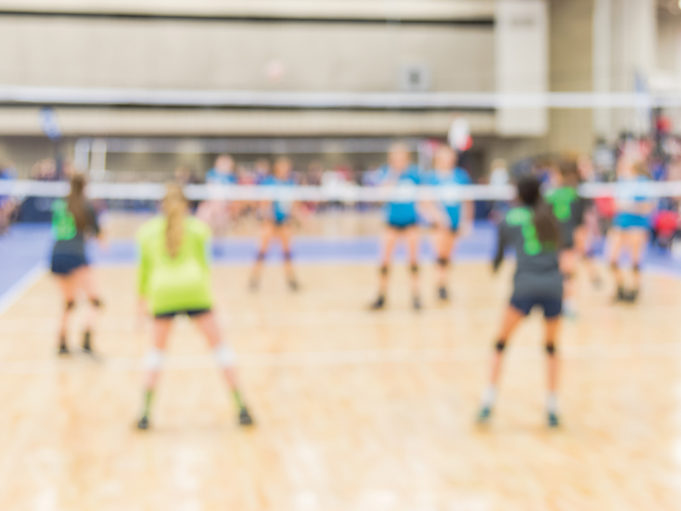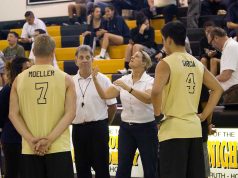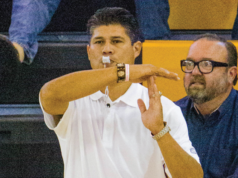A libero (LEE’-beh-ro) in indoor volleyball is a back-row defensive specialist. Since they only play in the back row, those players are often shorter than the front-row blockers and hitters but have impeccable ball-control skills. The position was created to promote ball-control. When they are on the floor, he or she is involved in every serve-receive pattern and is among the primary passers. Liberos are usually quick, agile defenders. When the they enter the court, he or she replaces a back-row teammate. The term “replacement” is used rather than “substitute” because their exchange does not reflect in a team’s substitution count.
The world first saw this new position in the 1998 FIVB World Championships, and use of that player has now been incorporated into USAV, NCAA and NFHS rules. The three governing bodies have similar rules.
The use of a libero increases the length of rallies because he or she is an outstanding passer, which provides the setter a greater number of accurate, successful passes to run the offense. They are not allowed to complete an attack-hit from anywhere on the court or free zone if the ball is completely above the top of the net at the moment of contact. They also may not block or attempt to block.
All three rule sets allow that in one rotation in the service order, the libero may replace the player in the serving position to serve. The coach must indicate the number of the player coming in on the lineup sheet. If no libero is listed on the starting lineup, none may be used in that set. The coach may change the libero in subsequent sets. For NFHS and NCAA rules only, the libero may be designated as the floor captain.
In order to be immediately recognizable on the court, the libero wears a different jersey from the rest of the team. Their jersey must be contrasting in color with the other team members’ jerseys and must have a visible legal number on the front and back.
Libero replacements occur across the sideline between the imaginary extensions of the attack line and end line (“libero replacement zone”). They are authorized at the start of each set by the second referee after he or she has checked each team’s lineup. Additional replacements must occur when the ball is out of play and before service authorization. Libero replacements are unlimited and do not count as substitutions. There must be at least one rally between replacements involving the libero, except when the libero on the court will be the next server. In that case, the libero on the court may move directly to the service position without exiting the court for a rally. The original server and the player who was replaced by the libero will exchange in the replacement zone in that case.
The only player who can replace the libero is the one whom the libero replaced. Once there has been a replacement, a substitution may take place immediately before the next service beckon. Replacements may not occur during timeouts, but may occur after a timeout has ended. For USAV, if two liberos are used by a team, only one libero may be on the floor at a time.
The libero tracker/assistant scorekeeper records libero replacements and substitutions. The scorekeeper records the libero number on the scoresheet; draws a triangle around the Roman numeral indicating the position in the service order where the libero serves; triangles the point or loss of rally in the individual scoring section (NFHS and NCAA only); and triangles the corresponding point in the running score if the libero’s service results in a point.
When the libero, who is on or in front of the attack line (in the “front zone”), uses overhand finger action to set the ball, a teammate may not complete an attack hit on that ball if the ball is entirely higher than the top of the net. The fault is signaled as an illegal attack, followed by indicating the libero (point toward them with an open hand).
If the libero is injured and cannot continue play, a new one may be re-designated by the coach at any time. Any substitute may be re-designated as the new libero and the former may not play in the remainder of the set (remainder of the match in USAV rules). In subsequent sets, if a new libero is listed on the lineup, the former may change jerseys and play as a regular player. NCAA and USAV rules require the libero’s uniform number to remain the same whether playing as a libero or a regular player. The libero may not be used as a substitute for expelled or disqualified teammates.
The libero may be used as an exceptional substitution for an injured player if no other substitutes exist; he or she must change into a regular uniform and the team continues with no libero. If the libero is disqualified, he or she must be replaced by the player whom he or she replaced; play continues with no libero.
With the introduction of the libero, defensive control has increased, fostering longer rallies. With the contrasting jersey that sets him or her apart from the other teammates, fans often closely follow this ball-control specialist in spectacular dives, digs and extraordinary passes in getting the ball to the target. As the game evolves, so does the speed of the game, due in great part, to the addition of the libero.
What's Your Call? Leave a Comment:
Note: This article is archival in nature. Rules, interpretations, mechanics, philosophies and other information may or may not be correct for the current year.
This article is the copyright of ©Referee Enterprises, Inc., and may not be republished in whole or in part online, in print or in any capacity without expressed written permission from Referee. The article is made available for educational use by individuals.


















